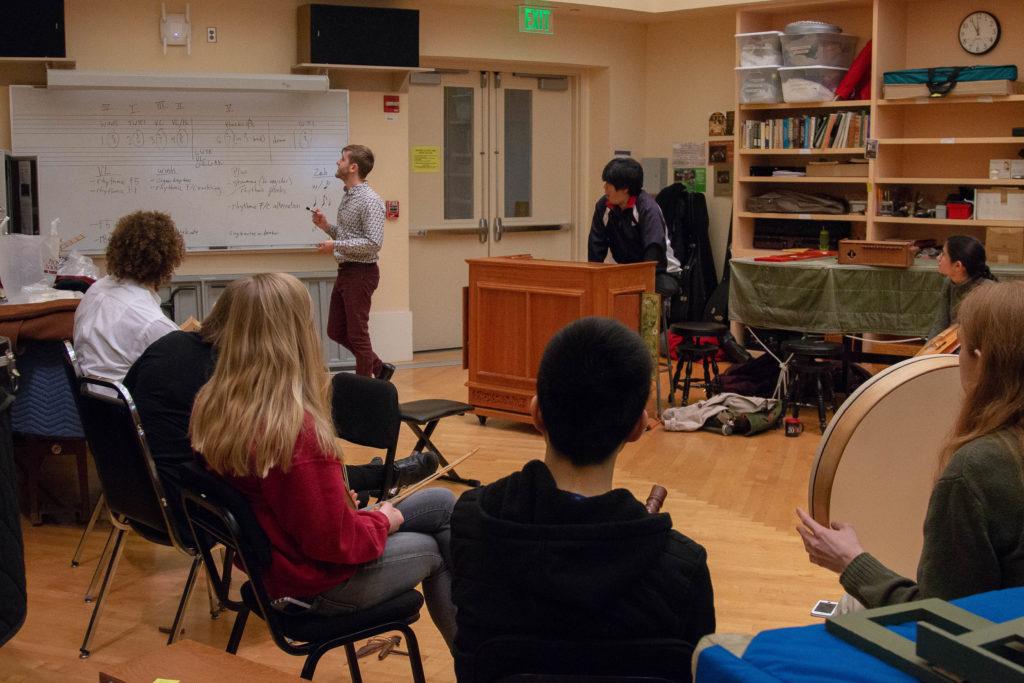By Chloe Wray
wraychlo@grinnell.edu
On April 12, Niccolo Seligmann, a multi-talented, improvisational and medieval-focused musician came to campus. He for three days to teach a series of workshops and perform a concert on Saturday, April 14.
Seligmann, who plays over 20 instruments, became fascinated with early music at age five when his parents brought him to a concert which featured the viola da gamba, a popular stringed instrument of the Renaissance. He played the cello until he was given a viola da gamba for his bar mitzvah.
When Seligmann was 18 and studying at the Peabody Institute of Johns Hopkins University, he discovered a passion for medieval music as he began teaching himself how to play the vielle, the viola da gamba’s predecessor.
In 2011, still at Peabody, Seligmann was invited to tour the country with The Broken Consort, a group with whom he still plays a mix of early and modern improvisational music. He also is a founding member of the band Alkemie, which plays exclusively medieval music.
In addition to playing with these groups, giving private lessons and acting as the viola da gamba coach for UCLA’s Early Music Ensemble, Seligmann is learning from his father-in-law, an expert at building early instruments.
“I have, as of 2018, begun my apprenticeship to him as a luthier and my goal as an instrument builder is to be able to build fiddles not only from pre-existing designs that you see in manuscripts but just totally from imagination — which is exactly what they would have done [in medieval times],” Seligmann said.
While he hopes to be able to see or imagine an instrument and build it, Seligmann has mastered the improvisational techniques of hearing a piece and learning it or being able to add an arrangement to a piece on the fly.
By nature, medieval music is improvisational. Throughout history, most musicians have played without knowing how to read music, and depended on an oral or auditory history.
“I have no written materials for this workshop, everything is oral, all of the tunes that they have learned, they learned them by ear and that’s how they would have done it back then,” Seligmann said, describing a particularly unique component of his workshop.
The medieval music that is available today is written on manuscripts, but there are many gaps which require improvisation to fill.
“I feel like medieval music is at the meeting place of classical, folk and world music traditions,” Seligmann said, calling upon these traditions as tools to fill the gaps. “Different musical communities improvise in different ways with different rules in different systems depending on where and when they are.”
Professor Jennifer Brown, music, invited Seligmann to campus after student Kate Perry ’20 met him at a workshop in Los Angeles, where Seligmann lives and works.
“I met him at a music party at a friend’s house, and it was amazing how quickly he could get a group of people with almost no prior experience (most of them playing modern instruments), immensely excited about medieval music. It seemed perfect for him to come to Grinnell, because we have a fairly large collection of medieval instruments, but no one to teach us how to play them — we mostly focus on the Renaissance and Baroque periods in Collegium,” Perry wrote in an email to The S&B.
Brown invited Niccolo to campus for his expertise in medieval improvisation, medieval stringed instruments and the viola da gamba.
“Thus he could provide students with a more diverse experience of music than I alone am able to provide,” Brown wrote. “There are lots of ideas in common between all types of musical improvisation: it was interesting to me that the format Niccolo used for his workshops was pretty similar to what I have observed Mark Laver do with the Grinnell Jazz Ensemble.”
For Perry, the improvisation was a completely new experience. She wrote, “As someone who’s been trained to read music from a printed page, it was really hard for me to adjust to improvising. I guess it’s a bit like spending years acting in scripted plays and then joining a comedy improv group — suddenly, you aren’t just delivering lines with emotion and energy, you’re inventing them on the spot! You have to be very aware of the structure of the music and the people you’re playing with.”
The program for Seligmann’s concert was comprised of pieces from Spain, France, Italy and England that were popular between 1200 and the late 1300s. While Seligmann performed most of the concert solo, the ensemble who participated in his workshops accompanied him on several pieces.
“We make music because we love it, and it is exhilarating to make music alongside a real virtuoso like Niccolo. … I hope the workshops helped [the students] to get over the fear of improvisation, of putting yourself out there in public, that we all feel — and especially classically trained musicians, who don’t have that many opportunities to improvise these days. … I hope they learned that medieval music is something that we today can relate to, enjoy, and find meaning and beauty in, even hundreds of years after it was composed,” Brown wrote.






























































